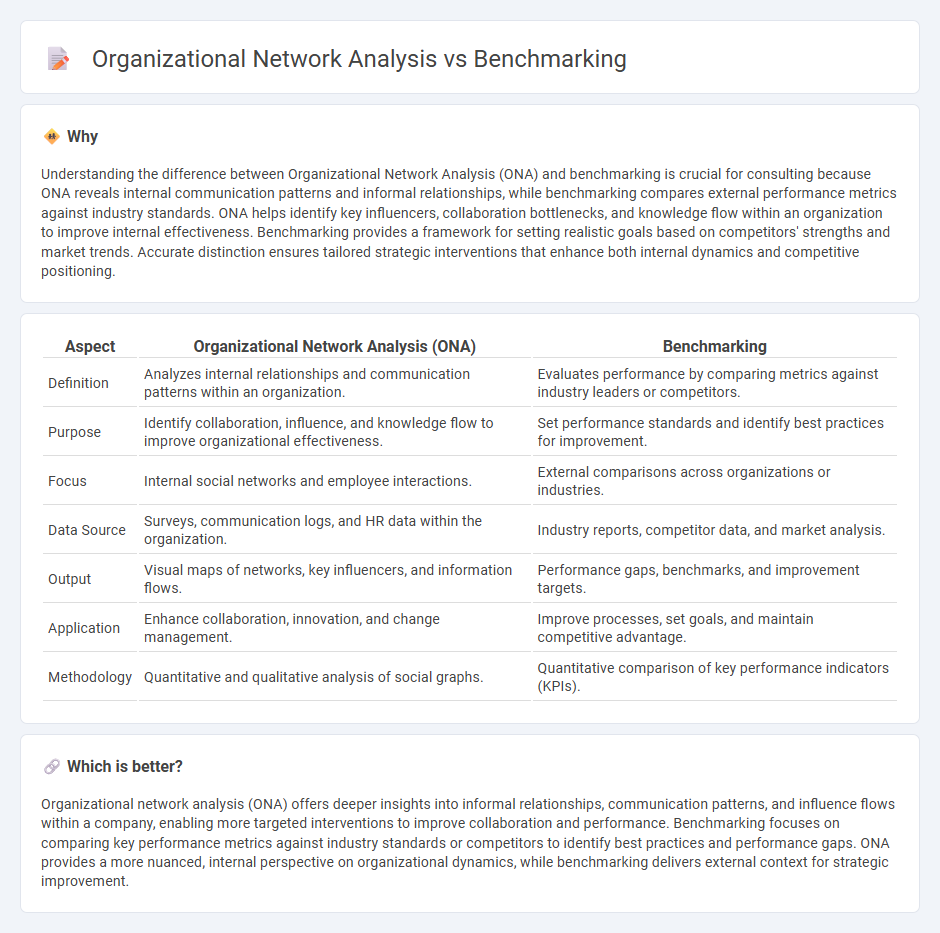
Organizational Network Analysis (ONA) maps relationships and communication patterns within a company to enhance collaboration, innovation, and decision-making effectiveness. Benchmarking compares organizational processes and performance metrics against industry best practices to identify improvement opportunities and competitive gaps. Explore how integrating ONA with benchmarking drives strategic insights and operational excellence.
Why it is important
Understanding the difference between Organizational Network Analysis (ONA) and benchmarking is crucial for consulting because ONA reveals internal communication patterns and informal relationships, while benchmarking compares external performance metrics against industry standards. ONA helps identify key influencers, collaboration bottlenecks, and knowledge flow within an organization to improve internal effectiveness. Benchmarking provides a framework for setting realistic goals based on competitors' strengths and market trends. Accurate distinction ensures tailored strategic interventions that enhance both internal dynamics and competitive positioning.
Comparison Table
| Aspect | Organizational Network Analysis (ONA) | Benchmarking |
|---|---|---|
| Definition | Analyzes internal relationships and communication patterns within an organization. | Evaluates performance by comparing metrics against industry leaders or competitors. |
| Purpose | Identify collaboration, influence, and knowledge flow to improve organizational effectiveness. | Set performance standards and identify best practices for improvement. |
| Focus | Internal social networks and employee interactions. | External comparisons across organizations or industries. |
| Data Source | Surveys, communication logs, and HR data within the organization. | Industry reports, competitor data, and market analysis. |
| Output | Visual maps of networks, key influencers, and information flows. | Performance gaps, benchmarks, and improvement targets. |
| Application | Enhance collaboration, innovation, and change management. | Improve processes, set goals, and maintain competitive advantage. |
| Methodology | Quantitative and qualitative analysis of social graphs. | Quantitative comparison of key performance indicators (KPIs). |
Which is better?
Organizational network analysis (ONA) offers deeper insights into informal relationships, communication patterns, and influence flows within a company, enabling more targeted interventions to improve collaboration and performance. Benchmarking focuses on comparing key performance metrics against industry standards or competitors to identify best practices and performance gaps. ONA provides a more nuanced, internal perspective on organizational dynamics, while benchmarking delivers external context for strategic improvement.
Connection
Organizational network analysis (ONA) maps and measures relationships within a company to identify communication patterns and influence structures, providing critical data for benchmarking processes. Benchmarking uses these insights to compare organizational performance against industry standards or best practices, highlighting gaps and opportunities for improvement. Integrating ONA with benchmarking enhances strategic consulting by offering a data-driven approach to optimize collaboration and operational efficiency.
Key Terms
Performance Metrics (Benchmarking)
Benchmarking emphasizes comparing performance metrics such as productivity, efficiency, and quality against industry standards or competitors to identify best practices and performance gaps. Organizational Network Analysis (ONA) focuses on mapping communication patterns and relationships within a company to understand collaboration and knowledge flow, rather than direct performance metrics. Explore further to understand how integrating these approaches can enhance organizational growth strategies.
Social Network Mapping (Organizational Network Analysis)
Social Network Mapping, a key component of Organizational Network Analysis (ONA), captures real-time relationships and informal communication patterns within an organization, unlike benchmarking which compares performance metrics against industry standards. ONA provides granular insights into collaboration, influence, and knowledge flow, revealing hidden leaders and bottlenecks that traditional benchmarking overlooks. Explore how integrating Social Network Mapping can transform your organizational effectiveness and drive strategic decision-making.
Best Practices Identification (Benchmarking)
Benchmarking involves systematically comparing organizational processes and performance metrics against industry leaders to identify best practices and improve efficiency. Organizational Network Analysis (ONA) maps and analyzes informal relationships and communication patterns within a company to enhance collaboration and knowledge sharing. Explore how integrating benchmarking with ONA can optimize best practices identification and drive organizational success.
Source and External Links
Benchmarking - Wikipedia - Benchmarking is the practice of comparing business processes and performance metrics to industry bests and best practices from other companies, typically measuring quality, time, and cost to identify improvement opportunities and adapt best practices.
What are the Four Types of Benchmarking? - APQC - Benchmarking can be categorized into key types including performance benchmarking, which compares quantitative data, and practice benchmarking, which compares qualitative information about how activities are conducted.
What is Benchmarking in Business? Process, Definition - Simpplr - Benchmarking is the process of measuring and comparing the performance, efficiency, or quality of products, services, or processes against recognized standards or competitors to identify areas for improvement and drive better performance.
 dowidth.com
dowidth.com